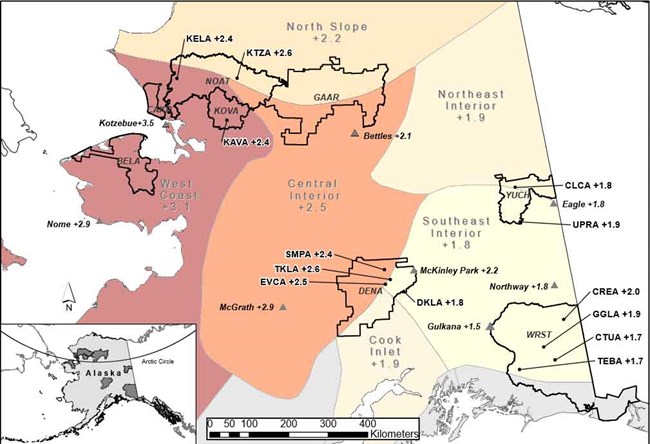Last updated: March 6, 2025
Article
Increasing temperatures in Alaska national parks

As air temperatures rise, soil temperatures are also getting warmer. For northern parks with permafrost soils, thawing can cause landscape-scale changes. Starting in 2014, an abrupt increase in the average annual temperature was observed in the central and northern Alaska parks. We compared average temperatures before and after the 2014 shift using monitoring stations in and around the parks. We found that average air temperatures rose by at least 1°C at most locations. The increase was near 2°C for Denali National Park and Preserve and most of Alaska's Arctic parks increased by 3°C. The temperature of the ground also rose by at least half this amount in most locations. This is not the first time Alaska's temperatures have shifted abruptly. A step-wise increase was also documented in the late 1970s attributed to warmer ocean temperatures around Alaska associated with the Pacific Decadal Oscillation.

Also note that the latest increase puts annual temperatures near the 0°C freezing threshold.
These northern parks are underlain with permafrost (ground that stays frozen year-round just below the surface due to cold climate). Even before this recent warming, large areas of permafrost had temperatures just below freezing, and with the increase in air and soil temperatures, large areas of permafrost have probably begun to thaw. Thawing permafrost has subtle effects in some environments, such as allowing the soil to get a little warmer and dryer in the summer. But where there is ice in the permafrost, thawing can produce pits and ponds and can even cause landslides to occur or lakes to suddenly drain.
The period between 2014 and 2019 was striking because each of those years was much warmer than normal and included four of the warmest years on record for Alaska. While future weather will continue to vary, projected increases in global CO2 emissions, diminishing sea ice off Alaska’s west coast, and changes in atmospheric circulation patterns all point to continued warming.
Increased mean annual temperatures in 2014–2019 indicate permafrost thaw in Alaskan national parks
Abstract
Rising temperatures in the Arctic can result in thaw of permafrost, with widespread implications for ecosystems and infrastructure. We analyzed mean annual air and ground temperatures in the eight northernmost national parks in Alaska using data from thirty-three National Park Service climate monitoring stations and eight National Weather Service stations. Mean annual air temperatures (MAATs) from 2014 to 2019 increased in a stepwise fashion relative to the preceding thirty-year period by at least 1°C at all locations in the study area; the increase was near 2°C in Denali National Park and most of the Arctic Alaska parks and 3°C in the far western coastal areas of the Arctic parks. The increase in mean annual ground temperatures (MAGT) was approximately equal to the increase in MAAT in windswept tundra areas with minimal snow, whereas under deeper taiga and alpine snowpacks the increase in MAGT was about half as large as the increase in MAAT. If the warm temperatures observed during 2014 to 2019 persist, there will be widespread degradation of permafrost in portions of these national parks and in similar environments across Alaska.
Swanson, D. K., P. J. Sousanes, and K. Hill. 2021. Increased mean annual temperatures in 2014-2019 indicate permafrost thaw in Alaskan national parks. Arctic, Antarctic, and Alpine Research 53(1): 1-19.
